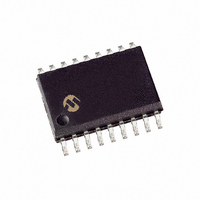PIC18LF1330-I/SO Microchip Technology, PIC18LF1330-I/SO Datasheet - Page 114

PIC18LF1330-I/SO
Manufacturer Part Number
PIC18LF1330-I/SO
Description
IC PIC MCU FLASH 4KX16 18SOIC
Manufacturer
Microchip Technology
Series
PIC® 18Fr
Datasheets
1.PIC16F616T-ISL.pdf
(8 pages)
2.AC162078.pdf
(318 pages)
3.PIC18F1230-ISO.pdf
(6 pages)
4.PIC18F1230-ISO.pdf
(12 pages)
5.PIC18F1230-ISO.pdf
(4 pages)
6.PIC18F1230-IP.pdf
(312 pages)
Specifications of PIC18LF1330-I/SO
Core Size
8-Bit
Program Memory Size
8KB (4K x 16)
Oscillator Type
Internal
Core Processor
PIC
Speed
40MHz
Connectivity
UART/USART
Peripherals
Brown-out Detect/Reset, LVD, POR, PWM, WDT
Number Of I /o
16
Program Memory Type
FLASH
Eeprom Size
128 x 8
Ram Size
256 x 8
Voltage - Supply (vcc/vdd)
2 V ~ 5.5 V
Data Converters
A/D 4x10b
Operating Temperature
-40°C ~ 85°C
Package / Case
18-SOIC (7.5mm Width)
Controller Family/series
PIC18
No. Of I/o's
16
Eeprom Memory Size
128Byte
Ram Memory Size
256Byte
Cpu Speed
40MHz
No.
RoHS Compliant
Processor Series
PIC18LF
Core
PIC
Data Bus Width
8 bit
Data Ram Size
256 B
Interface Type
EUSART
Maximum Clock Frequency
40 MHz
Number Of Programmable I/os
16
Number Of Timers
2
Maximum Operating Temperature
+ 85 C
Mounting Style
SMD/SMT
3rd Party Development Tools
52715-96, 52716-328, 52717-734, 52712-325, EWPIC18
Development Tools By Supplier
PG164130, DV164035, DV244005, DV164005, PG164120, DV164136
Minimum Operating Temperature
- 40 C
On-chip Adc
10 bit, 4 Channel
Lead Free Status / RoHS Status
Lead free / RoHS Compliant
Lead Free Status / RoHS Status
Lead free / RoHS Compliant
Available stocks
Company
Part Number
Manufacturer
Quantity
Price
Part Number:
PIC18LF1330-I/SO
Manufacturer:
MICROCHIP/微芯
Quantity:
20 000
- PIC16F616T-ISL PDF datasheet
- AC162078 PDF datasheet #2
- PIC18F1230-ISO PDF datasheet #3
- PIC18F1230-ISO PDF datasheet #4
- PIC18F1230-ISO PDF datasheet #5
- PIC18F1230-IP PDF datasheet #6
- Current page: 114 of 318
- Download datasheet (3Mb)
PIC18F1230/1330
13.4
The TMR1 register pair (TMR1H:TMR1L) increments
from 0000h to FFFFh and rolls over to 0000h. The
Timer1 interrupt, if enabled, is generated on overflow
which is latched in interrupt flag bit, TMR1IF
(PIR1<0>). This interrupt can be enabled/disabled by
setting/clearing Timer1 interrupt enable bit, TMR1IE
(PIE1<0>).
13.5
Timer1 can be configured for 16-bit reads and writes
(see Figure 13-2). When the RD16 control bit
(T1CON<7>) is set, the address for TMR1H is mapped
to a buffer register for the high byte of Timer1. A read
from TMR1L will load the contents of the high byte of
Timer1 into the Timer1 High Byte Buffer register. This
provides the user with the ability to accurately read all
16 bits of Timer1 without having to determine whether
a read of the high byte, followed by a read of the low
byte, is valid due to a rollover between reads.
A write to the high byte of Timer1 must also take place
through the TMR1H Buffer register. Timer1 high byte is
updated with the contents of TMR1H when a write
occurs to TMR1L. This allows a user to write all 16 bits
to both the high and low bytes of Timer1 at once.
The high byte of Timer1 is not directly readable or
writable in this mode. All reads and writes must take
place through the Timer1 High Byte Buffer register.
Writes to TMR1H do not clear the Timer1 prescaler.
The prescaler is only cleared on writes to TMR1L.
DS39758D-page 114
Timer1 Interrupt
Timer1 16-Bit Read/Write Mode
13.6
Adding an external LP oscillator to Timer1 (such as the
one described in Section 13.2 “Timer1 Oscillator”),
gives users the option to include RTC functionality to
their applications. This is accomplished with an
inexpensive watch crystal to provide an accurate time
base and several lines of application code to calculate
the time. When operating in Sleep mode and using a
battery or super capacitor as a power source, it can
completely eliminate the need for a separate RTC
device and battery backup.
The application code routine, RTCisr, shown in
Example 13-1, demonstrates a simple method to
increment a counter at one-second intervals using an
Interrupt Service Routine. Incrementing the TMR1
register pair to overflow triggers the interrupt and calls
the routine, which increments the seconds counter by
one. Additional counters for minutes and hours are
incremented as the previous counter overflow.
Since the register pair is 16 bits wide, counting up to
overflow the register directly from a 32.768 kHz clock
would take 2 seconds. To force the overflow at the
required one-second intervals, it is necessary to pre-
load it. The simplest method is to set the MSb of
TMR1H with a BSF instruction. Note that the TMR1L
register is never preloaded or altered; doing so may
introduce cumulative error over many cycles.
For this method to be accurate, Timer1 must operate in
Asynchronous mode and the Timer1 overflow interrupt
must be enabled (PIE1<0> = 1), as shown in the
routine, RTCinit. The Timer1 oscillator must also be
enabled and running at all times.
Using Timer1 as a Real-Time Clock
2009 Microchip Technology Inc.
Related parts for PIC18LF1330-I/SO
Image
Part Number
Description
Manufacturer
Datasheet
Request
R

Part Number:
Description:
Manufacturer:
Microchip Technology Inc.
Datasheet:

Part Number:
Description:
Manufacturer:
Microchip Technology Inc.
Datasheet:

Part Number:
Description:
Manufacturer:
Microchip Technology Inc.
Datasheet:

Part Number:
Description:
Manufacturer:
Microchip Technology Inc.
Datasheet:

Part Number:
Description:
Manufacturer:
Microchip Technology Inc.
Datasheet:

Part Number:
Description:
Manufacturer:
Microchip Technology Inc.
Datasheet:

Part Number:
Description:
Manufacturer:
Microchip Technology Inc.
Datasheet:

Part Number:
Description:
Manufacturer:
Microchip Technology Inc.
Datasheet:











